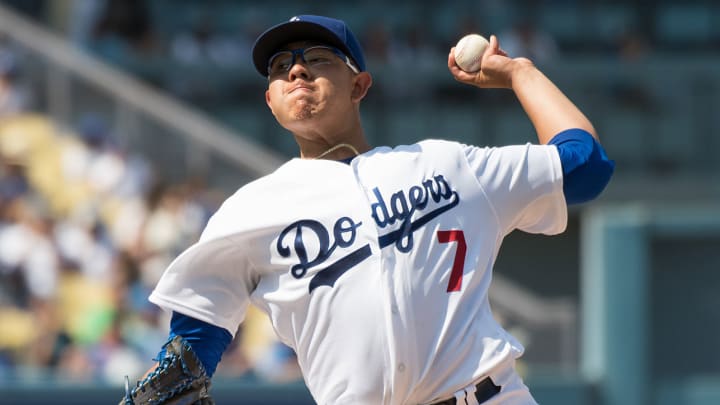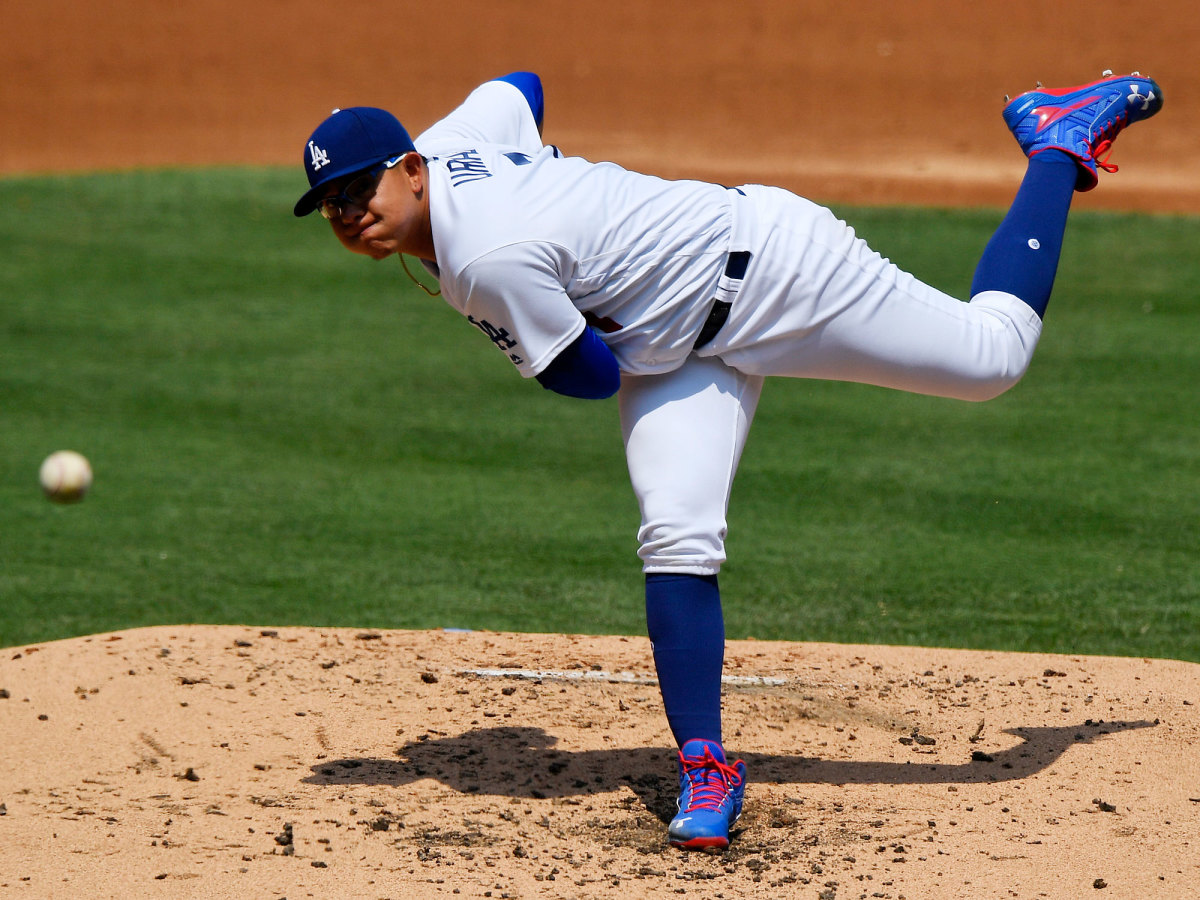Three Strikes: Dodgers' Julio Urias could get chance to make history in NLDS

WASHINGTON, D.C.—About two hours before rain forced the postponement of NLCS Game 2 on Saturday, Los Angeles Dodgers manager Dave Roberts, who had just seen Clayton Kershaw in the weight room after his ace’s arduous 101-pitch effort in the team's 4-3 win the previous night, confirmed that Kershaw remained an option to pitch on short rest in Game 4.
"It’s in play,” Roberts said. “He feels good."
But soon the rain took Kershaw out of play for Game 4. Losing an off day—Game 2 will now be played Sunday afternoon at 1 p.m. ET, with Game 3 still scheduled for Monday in Los Angeles—means Roberts will not bring back Game 2 starter Rich Hill on short rest for a potential Game 5 on Thursday. That means the rain set up a rematch between aces Max Scherzer and Kershaw in a winner-take-all game if it becomes necessary. But before we get there, the rain created another intriguing possibility: Game 4, also if necessary, now squarely belongs to Julio Urias, the rookie lefthander who will be 20 years and 60 days old on Tuesday. Nobody that young has ever won a postseason game.
The youngest postseason winner was Odalis Perez, who was 20 years, 112 days old when he picked up a win in relief for Atlanta against Chicago in the 1998 NLDS. The youngest starter to win a game was Bullet Joe Bush (20.316) in the 1913 World Series for the Philadelphia A’s.
And get this: The youngest starter to win a clinching game is Fernando Valenzuela, like Urias a native of Mexico and a Dodgers' lefthander, who was 20 years, 352 days old when he beat the Expos in the decisive Game 5 of the 1981 NLCS.
Valenzuela and Urias are two of the 35 big leaguers signed by famed scout Mike Brito, who was born in Cuba when Franklin Delano Roosevelt was president and signed Urias when Barack Obama was president. Brito, a former minor league catcher with the Senators, has been a Dodgers scout since 1978. He first saw Urias when the kid was just 14 and throwing 89 mph. When Brito saw Urias the next year the southpaw was hitting 94 mph with his fastball. On Aug. 23, 2012, just 11 days after turning 16, Urias signed with Los Angeles for $1.8 million, prompting Brito to later gush, “I’ve signed a lot of guys and I’ve never seen anyone like him. Even Sandy Koufax didn’t throw that hard when he was his age.”
The new generation of Dodgers baseball began with that signing. Only the year before, operating under embattled owner Frank McCourt, Los Angeles spent less than $200,000 on international players. The team couldn’t get prospects to come to its academy.
When the Guggenheim ownership group took over the Dodgers May 1, 2012, they asked then-GM Ned Colletti what should be the first order of business. He responded, “Invest now in Latin America and Mexico.”
Within three months the Dodgers spent $42 million on Cuban native YasielPuig and $1.8 million on Urias. A key figure in both signings was Brito. Urias has such a great feel for pitching, especially when it comes to spinning a baseball, that Brito thought he could pitch in the big leagues at 17 or 18. Urias made it there at age 19, debuting this May 27 against the Mets at Citi Field.

Urias is a rare pitching prodigy. He went 5-2 with a 3.39 ERA and 9.8 strikeouts per nine innings while appearing in 18 big league games this year, 15 of them starts. Urias and Dwight Gooden (31 starts in 1984) are the only pitchers in the past 41 years to make 15 starts or more in their age-19 season. After Urias threw only 87 2/3 and 80 innings, respectively, in his previous two seasons of pro ball, he logged 122 innings across the minors and majors this year. Mindful of the big increase at such a young age, the Dodgers allowed him to throw only 14 innings in September. But Urias continued to pitch so well in such sporadic work (a 1.93 ERA and 14 strikeouts that month), that Los Angeles decided he was hale enough to be its Game 4 starter. He will have pitched only three innings in the previous 19 days heading into that start.
Of course, Game 4 only becomes possible if the Nationals can win at least one of the next two games. Washington is scheduled to use Joe Ross in that game. Ross will be just 23 years and 144 days old himself that day. If Game 4 comes off as Urias vs. Ross, it will be the youngest pitching matchup ever in a potential clinching postseason game. Only two non-clinching games featured two starters younger than 23.144: The Rockies' Franklin Morales vs. the Phillies' Kyle Kendrick in Game 2 of the 2007 NLDS and—here we go again—Valenzuela vs. the Yankees' Dave Righetti in Game 3 of the 1981 World Series.
With a young Urias bumping up to a soft innings limit, Game 4 figures to be a bullpen game—but isn’t that most Dodgers games, anyway? If nothing else, just watching a 20-year-old lefthander from Mexico take the mound at Dodger Stadium with a chance to clinch the series or keep his team alive would be a historic sight to behold.
Speed and spin: As bullpens change, Roberts has Dodgers set up for success
2. Madison rushes to rescue
Facing elimination Monday, the San Francisco Giants will have to extend two of the most amazing records in baseball to push their NLDS against the Chicago Cubs to a Game 4. The Giants under manager Bruce Bochy are 9-0 when facing elimination in the postseason. And Madison Bumgarner, their Game 3 starter in San Francisco, has not allowed a run in 23 innings in potential elimination games. That's the most in baseball history, and the four nearest competitors—Tom Hall (12), Alan Embree (9 1/3), Jeff Nelson (9) and Sparky Lyle (8 2/3)—were all relievers. Bumgarner's wok in such games, famously, includes a relief appearance in Game 7 of the 2014 World Series, when he closed out the Royals with five scoreless innings. Overall he is 2-0 with 20 strikeouts and just three walks in elimination games, to go with his 0.00 ERA. Here's a look at the pitchers who have the lowest career ERA in such games with a minimum of 20 innings pitched.
Pitcher | Innings pitched | ERA |
|---|---|---|
Madison Bumgarner | 23 | 0.00 |
Mariano Rivera | 20 2/3 | 0.44 |
Curt Schilling | 39 1/3 | 1.37 |
Whitey Ford | 26 1/3 | 1.37 |
Josh Beckett | 26 | 1.38 |
Bumgarner is one reason why San Francisco has played so well under the ultimate pressure and haven't lost an elimination game since the 2003 NLDS (when the Marlins beat them in a game started by a pair of 21-year-olds, the Marlins' Dontrelle Willis and the Giants' Jerome Williams). Here's another key to remember when the Giants play Monday: They scored the first run in seven of those nine elimination games. Getting out in front of the Cubs (San Francisco has yet to get a lead) will be even more important than usual.
And maybe the Giants are getting a “break” by facing Chicago's Jake Arrieta, the 2015 Cy Young Award winner, in Game 3. San Francisco opened this postseason with a gauntlet of pitchers who ranked 3-2-1 in the league in ERA: the Mets' Noah Syndergaard (2.60, NL wild-card game) and the Cubs' Jon Lester (2.44, in NLDS Game 1) and Kyle Hendricks (2.13, in NLDS Game 2). The Giants hit .183 and scored five runs in those three games. Arrieta? Poor guy ranked only 10th in the league in ERA.
Ghostbusters: Cubs have everything it takes to finally win World Series
3. NL rules rule, again
I bring this up often this time of year, because it’s always worth a reminder after people annually whine about how baseball should get rid of the DH when they see an AL team playing in an NL park during the regular season: The best, most dramatic and most memorable postseason games almost always are the ones played under NL rules. And in less than a week of games this year, the evidence keeps piling up:
• Roberts and Nationals manager Dusty Baker combined to use 33 players in NLDS Game 1, including 14 players in their respective eighth and ninth spots alone. In one inning, the eighth, Baker emptied his bench by using three pinch-hitters and one pinch-runner. That meant that if catcher Jose Lobaton had to leave the game in the ninth inning, Baker would have been forced to shift one of his position players to catcher, replacing that player with a pitcher.
Asked whom he considers his emergency third catcher, Baker thought for a moment and answered, “[Chris] Heisey?” But Heisey already had been used as a pinch hitter.
Can you imagine if in a playoff game former high school catcher Bryce Harper had to put on the equipment and catch?
"He’s always telling me, ‘I can play third, you know. I can play short …” Baker said. "So I’m sure he would say he could [catch]."
2016 MLB postseason: Complete schedule, TV listings, recaps
• In that same game, Roberts set up an elaborate decoy to try to trick Baker into pitching to Puig with runners at second and third. With closer Kenley Jansen on deck, Roberts ordered Josh Fields to start throwing in the bullpen and Andre Either to go to the on-deck circle to appear to be getting ready to hit for Jansen. If, as Roberts hoped, Baker believed that the lefthanded Ethier actually would hit for Jansen against righthanded pitcher Mark Melancon, maybe Baker would pitch to the righthanded Puig rather than intentionally walking Ethier.
"I knew he wouldn’t go for it," Roberts laughed, "but I wanted to take a shot anyway."
Baker walked Puig. Jansen, hitting for himself in the leadoff position in the batting order, struck out.
• In NLDS Game 2, Giants manager Bruce Bochy used Bumgarner as a pinch hitter, the first Giants pitcher to pinch hit in the postseason since Jack Bentley in 1924. Bentley was born in 1895 and served in World War I. Bumgarner, who has hit 12 home runs combined over the past three seasons, reached on an error but was left stranded.
• Also in NLDS Game 2, Travis Wood of the Cubs became the first relief pitcher to hit a postseason home run since Rosy Ryan, also in 1924.
None of it would have been likely under dumbed-down AL rules.
